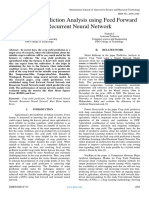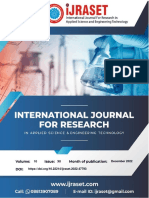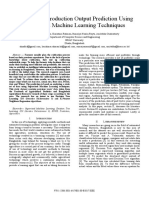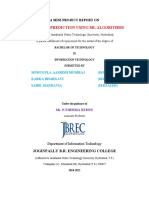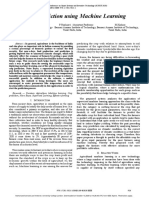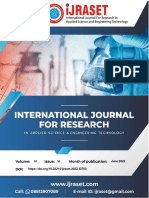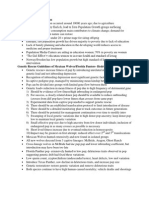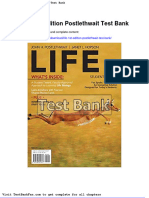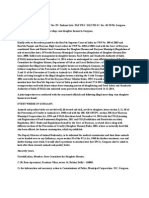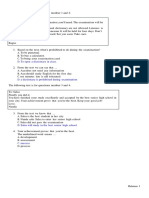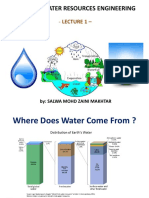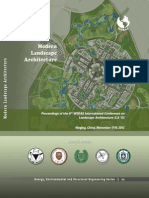Professional Documents
Culture Documents
Prediction of Agricultural Crops Using KNN Algorithm
Copyright
Available Formats
Share this document
Did you find this document useful?
Is this content inappropriate?
Report this DocumentCopyright:
Available Formats
Prediction of Agricultural Crops Using KNN Algorithm
Copyright:
Available Formats
Volume 5, Issue 5, May – 2020 International Journal of Innovative Science and Research Technology
ISSN No:-2456-2165
Prediction of Agricultural Crops using KNN Algorithm
H. K. Karthikeya1*, K. Sudarshan2, Disha S. Shetty3
1,3
Student, Department of Computer Science & Engineering, Srinivas Institute of Technology, Mangaluru, India
2
Associate Professor, Department of Computer Science & Engineering, Srinivas Institute of Technology, Mangaluru, India
Abstract- Agriculture is full of uncertainty due to climate neighbors to be the prediction query object. As mentioned
change, rainfall, soil type and numerous other factors. before it can also be used for regression-output, which is the
Crop prediction in agriculture is a very big dilemma and item's reward .Mostly for distance calculation in K-NN
there is huge dataset where farmers find difficult to algorithm the metric used is Euclidean distance.
predict the yield and seed selection. In this current
situation due to rise in the population the production of crops II. PROBLEM STATEMENT
and agricultural products needs to be increased
simultaneously to meet the demands of the people. These In country like India the production of crops are affected by
problems could be solved using machine learning several factors. Factors like Humidity, temperature, rainfall, soil
algorithms and this paper focuses on these solutions. The type play a vital role in crop prediction, and factors like these differ
real time environmental parameters like soil type, rainfall, by large with respect to region. In India farmers majorly still rely on
humidity etc of Mangalore, Kodagu, Kasaragod and some traditional techniques inherited from their forefathers. These
other districts of Karnataka state are collected and crop techniques would work earlier when the climate was much
prediction is done along with the accuracy for the crops is healthier and predictable. Now with factors like global warming
done with the help of K-NN algorithm. and pollution affecting the environment people have to be smart
and start utilizing modern techniques. It is time to analyze large set
Keywords:- Agriculture, Crop-Prediction, K-Nearest of data and come up with a system that can provide sufficient
Neighbor . information regarding crop yield. The new age methodology
requires large structured data sets and an algorithm capable of
I. INTRODUCTION providing solution using the provided datasets.
India is an agricultural country. India’s economy is III. METHODOLOGY
determined by agricultural products export and import.
Agriculture is one of the important aspects of Indian A. Dataset Collection
economy. Due to uncertainty in the crop yield there is a great When implementing an accurate prediction model it
fall in the economic status. The major crops of India are Rice, might not be sufficient to just consider one or two parameters.
Wheat, Pulses and Grains. Day by day the population of India Data about Rainfall, temperature, humidity and various other
is growing and the crops productivity need to be increased to factors are collected and analyzed. This analysis will be fed to
feed the population. One of the best ways of predicting the prediction model.
unknown values is by use of machine learning algorithms.
This work intends to develop crop prediction model using
machine learning. The application intends to predict crop yield
so it could help farmer to choose best seeds for plantation.
There are plenty of ML algorithms which could be used,
algorithms like Regression analysis, Support Vector Machine,
Neural Networks, K-Nearest Neighbor (K-NN) can be
utilized. In this work we discuss about K-NN. The k-nearest
neighbors (KNN) algorithm is a simple, supervised machine learning
algorithm that can be used to solve both classification and regression Fig 1:- Flow graph of the methodology Data Collection
problems. It’s easy to implement and understand, but has a major
drawback of becoming significantly slows as the size of that data in Here we gather information from several sources and
use grows. Here objective is to use a model where information construct datasets. Plenty of online portals like Raitha-mithra,
focuses are clustered in a few groups in order to predict the karnataka.gov.in and Data.gov.in [1] are available for information
classification of another instance. K-NN works based on collection. Annual crop report of each crop is collected
minimum distance from query instance to the training samples Collecting previous crop history data from places like
to determine the k-nearest neighbors. Then we collect k- Mangalore, Kodagu, Kasaragod, Mysore, Davangere, Hassan,
nearest neighbors, we take simple majority of these k-nearest Shivamogga, Chikkamagalur which belongs to Karnataka State.
IJISRT20MAY722 www.ijisrt.com 1422
Volume 5, Issue 5, May – 2020 International Journal of Innovative Science and Research Technology
ISSN No:-2456-2165
Collecting data related to crops like Coconut, Cardamom, IV. TESTING AND ANALYSIS
Coffee, Areca nut, Ginger, Tea, Paddy, Ground nut, Black
gram, Cashew, Pepper are the crops which are commonly The purpose of the test was to find the workings of K-
grown in these regions. We also collect data related to NN algorithm and how will it predict the yield when three
Rainfall. Humidity, Soil type, Irrigation type, Previous Yields, parameters were given as input. Input data is given as follows
Location, Price, Year, type of crop, Crop diseases and its Location: Mangalore, Soil-Type: Coastal alluvial and Area:
symptoms 1395 cents. The system predicted Coconut and Cocoa as two
potential crops with the accuracy of 63.63%. While testing for
B. K-NN Algorithm Kodagu district the where soil type is Laterite soil and the area
The k-nearest neighbor (k-NN) method is a data mining given was 1395 cents the system predicted Cardamom and
technique considered to be among the top five techniques for Pepper as two potential crops and noted the accuracy of
data mining. In this, we consider each of the characteristics in 56.66%
our training set as a different dimension in some space, and
take the value an observation has for this characteristic to be
its coordinate in that dimension, so getting a set of points in
space. We can then consider the similarity of two points to be
the distance between them in this space under some
appropriate metric. The way in which the algorithm decides
which of the points from the training set are similar enough to
be considered when choosing the class to predict for a new
observation is to pick the k closest data points to the new
observation, and to take the most common class among these.
This is why it is called the k Nearest Neighbors algorithm. The
implementation of algorithm can be noted as below :
1. Load the data
2. Initialize K to your chosen number of neighbors
3. For each example in the data
Calculate the distance between the query example and the Fig 2:- Accuracy of KNN Algorithm for Mangalore Region
current example from the data.
Add the distance and the index of to an ordered collection.
4. Sort the ordered collection of distances and indices from
smallest to largest (in ascending order) by the distances
5. Pick the first K entries from the sorted collection
6. Get the labels of the selected K entries
7. If regression, return the mean of the K labels
8. If classification, return the mode of the K labels
C. Prediction of Crop Yield through KNN
Here we consider parameters like humidity, rainfall, soil
type, area etc. We have assigned location, area, soil type as
input parameters although other parameters may also be
considered. The crop yield which is an unknown value can be
predicted using the values of the nearest known neighbors.
This is possible by calculation Euclidian distance between
those points. Thus we will be able to predict crop yield for the
given input parameters. The calculation of distance between
points in a feature space, different distance functions could be Fig 3:- Accuracy of KNN Algorithm for Kodagu Region
used, in which the Euclidean distance function is the most
commonly used one. Say p and q are represented as feature The system helps in avoiding the use of sensors and
vectors. To measure the distance between p and q, the reduces unnecessary cost. This system results in efficient
Euclidean metric is generally used by if a = (a1, a2) and b = usage of time and cost. A key aspect of Crop Prediction is to
(b1,b2) then the distance is given by: identify a suitable crop quickly and suggest the farmer as to
which crop to grow. Our system helps in gathering all
necessary information and giving a model of output which not
d(a, b) = √(𝑏1 − 𝑎1)2 + (𝑏2 − 𝑎2)2 only increases current economical gain but also safeguards
future profitability. The accuracy part of the system is noted as
IJISRT20MAY722 www.ijisrt.com 1423
Volume 5, Issue 5, May – 2020 International Journal of Innovative Science and Research Technology
ISSN No:-2456-2165
decent but can be made more accurate with increase in the
efficiency.
V. CONCLUSION
The implementation of the system was to learn about
crops and agriculture and find an efficient way of harvesting.
The study focuses on the agricultural datasets obtained from
various portals belonging to some districts of Karnataka State.
Datasets ordered in well structured manner. K-NN algorithm
is used for the prediction model and crop yield prediction and
its accuracy is obtained. The future is bright for the
implementation of machine learning algorithms in the field of
crop production and we hope to implement more advanced
algorithms so that the system becomes more efficient, we hope
to make system prediction more stable and obtain high
accuracy with the help of more datasets and advanced
algorithms.
REFRENCES
[1]. P. Vinciya “Agriculture Analysis for Next Generation
High Tech Farming in Data Mining”, Anna University,
Trichy, Tamilnadu, India, 5 May,2016.
[2]. M. A. Jayaram and Netra Marad,” Fuzzy Inference
Systems for Crop Yield Prediction”, Journal of
Intelligent Systems, 2012,21(4),pp.363-372.
[3]. Sk Al Zaminur Rahman, Kaushik Chandra Mitra, Soil
Classification using Machine Learning Methods and
Crop Suggestion Based on Soil Series,2018 21st
International Conference of Computer and Information
Technology (ICCIT), 21-23 December 2018.
[4]. Hart, Peter E. (1968). "The Condensed Nearest
Neighbor Rule". IEEE Transactions on Information
Theory. 18: 515–516. doi:10.1109/TIT.1968.1054155
[5]. http://agricoop.nic.in/sites/default/files/Annual_rpt_2016
17_E.pdf.
IJISRT20MAY722 www.ijisrt.com 1424
You might also like
- 04 - RA - Crop Prediction Using Machine LearningDocument12 pages04 - RA - Crop Prediction Using Machine LearningBrad MurdochNo ratings yet
- Chapter-1 1.1 OverviewDocument44 pagesChapter-1 1.1 OverviewBollam Pragnya 518No ratings yet
- Integrating Soil Nutrients and Location Weather Variables For Crop Yield PredictionDocument7 pagesIntegrating Soil Nutrients and Location Weather Variables For Crop Yield PredictionInternational Journal of Innovative Science and Research TechnologyNo ratings yet
- CropDocument5 pagesCropSelva rajNo ratings yet
- Crop Yield Prediction Analysis Using Feed Forward and Recurrent Neural NetworkDocument5 pagesCrop Yield Prediction Analysis Using Feed Forward and Recurrent Neural NetworkInternational Journal of Innovative Science and Research TechnologyNo ratings yet
- Crop, Fertilizer, & Irrigation Recommendation Using Machine Learning TechniquesDocument9 pagesCrop, Fertilizer, & Irrigation Recommendation Using Machine Learning TechniquesIJRASETPublicationsNo ratings yet
- Paper 1Document6 pagesPaper 1uchiha itachiNo ratings yet
- Crop Yield Prediction Using Machine Learning AlgorithmsDocument51 pagesCrop Yield Prediction Using Machine Learning AlgorithmsBhasutkar Mahesh100% (2)
- Crop Report FinalDocument33 pagesCrop Report FinalHimanshu Kaushik100% (2)
- Analysis of Crop Yield Prediction Using Data Mining TechniquesDocument4 pagesAnalysis of Crop Yield Prediction Using Data Mining TechniquesSelva rajNo ratings yet
- Crop Yield Prediction Using Machine LearningDocument8 pagesCrop Yield Prediction Using Machine LearningIJRASETPublicationsNo ratings yet
- Crop Yield Prediction Using ML Algorithms: A Mini Project Report OnDocument9 pagesCrop Yield Prediction Using ML Algorithms: A Mini Project Report OnMd Talha KhanNo ratings yet
- Crop Prediction System Using Machine LearningDocument3 pagesCrop Prediction System Using Machine LearningEditor IJTSRDNo ratings yet
- Irjet V7i51491Document6 pagesIrjet V7i5149120-504 SrivalliNo ratings yet
- Crop Yield Prediction Based On Indian Agriculture Using Machine LearningDocument56 pagesCrop Yield Prediction Based On Indian Agriculture Using Machine LearningV Manohar100% (1)
- Crop Yield PaperDocument4 pagesCrop Yield PaperNilesh BangarNo ratings yet
- A Model For Prediction of Crop Yield: Pachaiyappas College India Pachaiyappas College IndiaDocument8 pagesA Model For Prediction of Crop Yield: Pachaiyappas College India Pachaiyappas College IndiaKOLLIPALLI HARIPRASADNo ratings yet
- Crop Price Prediction Using Machine LearningDocument5 pagesCrop Price Prediction Using Machine LearningTejas hvNo ratings yet
- Crop Prediction System Using Machine LearningDocument3 pagesCrop Prediction System Using Machine LearningEditor IJTSRDNo ratings yet
- Yield Prediction Using Machine LearningDocument8 pagesYield Prediction Using Machine Learningmayurb3420% (1)
- Crop Yeild SystemDocument71 pagesCrop Yeild Systemteja internet xeroxNo ratings yet
- Prediction of Plantation and Their ProfitsDocument33 pagesPrediction of Plantation and Their Profitssuresh mpNo ratings yet
- Crop Yield Prediction Using ML AlgorithmsDocument8 pagesCrop Yield Prediction Using ML Algorithms385swayamNo ratings yet
- Kali Muthu 2020Document7 pagesKali Muthu 2020Arshanday UkundamayNo ratings yet
- Crop Management System Using Machine LearningDocument3 pagesCrop Management System Using Machine LearningInternational Journal of Innovative Science and Research TechnologyNo ratings yet
- Crop Prediction Using Machine Learning: N.L. Chourasiya, P. Modi, N. Shaikh, D. Khandagale, S. PawarDocument5 pagesCrop Prediction Using Machine Learning: N.L. Chourasiya, P. Modi, N. Shaikh, D. Khandagale, S. PawarSreedhar NagavellyNo ratings yet
- IOT Based Crop & Fertilizer Recommendation System Using Machine LearningDocument9 pagesIOT Based Crop & Fertilizer Recommendation System Using Machine LearningIJRASETPublicationsNo ratings yet
- Crop Recomendation System Using Machine LearningDocument5 pagesCrop Recomendation System Using Machine LearningVENKAT VIJAY MPNo ratings yet
- Crop Recommendation System For Madhya Pradesh Districts Using Machine LearningDocument4 pagesCrop Recommendation System For Madhya Pradesh Districts Using Machine LearningInternational Journal of Innovative Science and Research TechnologyNo ratings yet
- Machine Learning PaperDocument5 pagesMachine Learning PaperAshutoshNo ratings yet
- Crop Disease PredictionDocument14 pagesCrop Disease PredictionPooja GNo ratings yet
- A Survey On Crop Prediction Using Machine Learning ApproachDocument4 pagesA Survey On Crop Prediction Using Machine Learning ApproachKOLLIPALLI HARIPRASADNo ratings yet
- Prediction of Crop Yield Using LS-SVMDocument3 pagesPrediction of Crop Yield Using LS-SVMEditor IJRITCCNo ratings yet
- A Novel Strategy For Predicting Agriculture Crop and Its YieldDocument5 pagesA Novel Strategy For Predicting Agriculture Crop and Its YieldInternational Journal of Innovative Science and Research TechnologyNo ratings yet
- IJRPR14070Document7 pagesIJRPR14070Gumar YuNo ratings yet
- IJRTI2304198Document4 pagesIJRTI2304198Tejas hvNo ratings yet
- Agroconsultant: Intelligent Crop Recommendation System Using Machine Learning AlgorithmsDocument6 pagesAgroconsultant: Intelligent Crop Recommendation System Using Machine Learning AlgorithmsSunny Chowdhary MuppalaNo ratings yet
- Crop Price Prediction using Machine LearningDocument5 pagesCrop Price Prediction using Machine LearningInternational Journal of Innovative Science and Research TechnologyNo ratings yet
- Harvest Forecasting of Crop Yield Using Machine LearningDocument5 pagesHarvest Forecasting of Crop Yield Using Machine LearningIJRASETPublicationsNo ratings yet
- Crop Recommendation System Using KNN and Random Forest Considering Indian DatasetDocument13 pagesCrop Recommendation System Using KNN and Random Forest Considering Indian DatasetNishith GuptaNo ratings yet
- Prediction of Crop Compliant System Using Machine Learning TechniquesDocument5 pagesPrediction of Crop Compliant System Using Machine Learning TechniquesInternational Journal of Innovative Science and Research TechnologyNo ratings yet
- Research PaperDocument8 pagesResearch Paper385swayamNo ratings yet
- Agricultural Crop YieldDocument7 pagesAgricultural Crop YieldBruce KingNo ratings yet
- Data mining techniques for predicting crop productivityDocument4 pagesData mining techniques for predicting crop productivityzuhan rasheedNo ratings yet
- Crop Yield Prediction and Efficient Use of FertilizersDocument3 pagesCrop Yield Prediction and Efficient Use of Fertilizersone lightNo ratings yet
- Crop Yield Prediction Using ML AlgorithmsDocument8 pagesCrop Yield Prediction Using ML Algorithms385swayamNo ratings yet
- Ijresm V5 I6 32Document3 pagesIjresm V5 I6 32Jatin KumarNo ratings yet
- Crop Advisor: A Software Tool For Forecasting Paddy YieldDocument5 pagesCrop Advisor: A Software Tool For Forecasting Paddy YieldBONFRINGNo ratings yet
- Crop Yield Prediction Using Machine Learning-IJRASETDocument5 pagesCrop Yield Prediction Using Machine Learning-IJRASETIJRASETPublications0% (1)
- Soil Classification Using Machine Learning and Crop SuggestionsDocument7 pagesSoil Classification Using Machine Learning and Crop SuggestionsIJRASETPublicationsNo ratings yet
- Prediction of Crop Using SVM AlgorithmDocument5 pagesPrediction of Crop Using SVM AlgorithmIJRASETPublications100% (1)
- Crop Yield Prediction Using Machine Learning Algorithms IJERTCONV9IS13019Document5 pagesCrop Yield Prediction Using Machine Learning Algorithms IJERTCONV9IS13019lovely bhanuNo ratings yet
- Journal CropDocument10 pagesJournal Cropkishanselvarajah80No ratings yet
- Computer NetworksDocument7 pagesComputer NetworksSahil KNo ratings yet
- Analysis of Agriculture Data Using Data Mining TecDocument16 pagesAnalysis of Agriculture Data Using Data Mining TecShashi KaranNo ratings yet
- Crop Yield Prediction Using ML AlgorithmsDocument8 pagesCrop Yield Prediction Using ML Algorithms385swayamNo ratings yet
- Crop Yield Prediction Using ML AlgorithmsDocument8 pagesCrop Yield Prediction Using ML Algorithms385swayamNo ratings yet
- Machine Learning Based Crop Recommendation System For Local Farmers of PakistanDocument12 pagesMachine Learning Based Crop Recommendation System For Local Farmers of PakistanPavitra DeviNo ratings yet
- Agricultural Crop Recommendations based on Productivity and SeasonDocument5 pagesAgricultural Crop Recommendations based on Productivity and SeasonNATIONAL ATTENDENCENo ratings yet
- Remote Sensing in Agriculture : Using Satellites for Crop MonitoringFrom EverandRemote Sensing in Agriculture : Using Satellites for Crop MonitoringNo ratings yet
- Forensic Evidence Management Using Blockchain TechnologyDocument6 pagesForensic Evidence Management Using Blockchain TechnologyInternational Journal of Innovative Science and Research TechnologyNo ratings yet
- Food habits and food inflation in the US and India; An experience in Covid-19 pandemicDocument3 pagesFood habits and food inflation in the US and India; An experience in Covid-19 pandemicInternational Journal of Innovative Science and Research TechnologyNo ratings yet
- Severe Residual Pulmonary Stenosis after Surgical Repair of Tetralogy of Fallot: What’s Our Next Strategy?Document11 pagesSevere Residual Pulmonary Stenosis after Surgical Repair of Tetralogy of Fallot: What’s Our Next Strategy?International Journal of Innovative Science and Research TechnologyNo ratings yet
- Late Presentation of Pulmonary Hypertension Crisis Concurrent with Atrial Arrhythmia after Atrial Septal Defect Device ClosureDocument12 pagesLate Presentation of Pulmonary Hypertension Crisis Concurrent with Atrial Arrhythmia after Atrial Septal Defect Device ClosureInternational Journal of Innovative Science and Research TechnologyNo ratings yet
- Databricks- Data Intelligence Platform for Advanced Data ArchitectureDocument5 pagesDatabricks- Data Intelligence Platform for Advanced Data ArchitectureInternational Journal of Innovative Science and Research TechnologyNo ratings yet
- Design and Development of Controller for Electric VehicleDocument4 pagesDesign and Development of Controller for Electric VehicleInternational Journal of Innovative Science and Research TechnologyNo ratings yet
- The Experiences of Non-PE Teachers in Teaching First Aid and Emergency Response: A Phenomenological StudyDocument89 pagesThe Experiences of Non-PE Teachers in Teaching First Aid and Emergency Response: A Phenomenological StudyInternational Journal of Innovative Science and Research TechnologyNo ratings yet
- Scrolls, Likes, and Filters: The New Age Factor Causing Body Image IssuesDocument6 pagesScrolls, Likes, and Filters: The New Age Factor Causing Body Image IssuesInternational Journal of Innovative Science and Research TechnologyNo ratings yet
- The Students’ Assessment of Family Influences on their Academic MotivationDocument8 pagesThe Students’ Assessment of Family Influences on their Academic MotivationInternational Journal of Innovative Science and Research Technology100% (1)
- Design and Implementation of Homemade Food Delivery Mobile Application Using Flutter-FlowDocument7 pagesDesign and Implementation of Homemade Food Delivery Mobile Application Using Flutter-FlowInternational Journal of Innovative Science and Research TechnologyNo ratings yet
- Targeted Drug Delivery through the Synthesis of Magnetite Nanoparticle by Co-Precipitation Method and Creating a Silica Coating on itDocument6 pagesTargeted Drug Delivery through the Synthesis of Magnetite Nanoparticle by Co-Precipitation Method and Creating a Silica Coating on itInternational Journal of Innovative Science and Research TechnologyNo ratings yet
- Anxiety, Stress and Depression in Overseas Medical Students and its Associated Factors: A Descriptive Cross-Sectional Study at Jalalabad State University, Jalalabad, KyrgyzstanDocument7 pagesAnxiety, Stress and Depression in Overseas Medical Students and its Associated Factors: A Descriptive Cross-Sectional Study at Jalalabad State University, Jalalabad, KyrgyzstanInternational Journal of Innovative Science and Research Technology90% (10)
- Blockchain-Enabled Security Solutions for Medical Device Integrity and Provenance in Cloud EnvironmentsDocument13 pagesBlockchain-Enabled Security Solutions for Medical Device Integrity and Provenance in Cloud EnvironmentsInternational Journal of Innovative Science and Research TechnologyNo ratings yet
- Quality By Plan Approach-To Explanatory Strategy ApprovalDocument4 pagesQuality By Plan Approach-To Explanatory Strategy ApprovalInternational Journal of Innovative Science and Research TechnologyNo ratings yet
- Enhancing Biometric Attendance Systems for Educational InstitutionsDocument7 pagesEnhancing Biometric Attendance Systems for Educational InstitutionsInternational Journal of Innovative Science and Research TechnologyNo ratings yet
- Investigating the Impact of the Central Agricultural Research Institute's (CARI) Agricultural Extension Services on the Productivity and Livelihoods of Farmers in Bong County, Liberia, from 2013 to 2017Document12 pagesInvestigating the Impact of the Central Agricultural Research Institute's (CARI) Agricultural Extension Services on the Productivity and Livelihoods of Farmers in Bong County, Liberia, from 2013 to 2017International Journal of Innovative Science and Research TechnologyNo ratings yet
- Optimizing Sound Quality and Immersion of a Proposed Cinema in Victoria Island, NigeriaDocument4 pagesOptimizing Sound Quality and Immersion of a Proposed Cinema in Victoria Island, NigeriaInternational Journal of Innovative Science and Research TechnologyNo ratings yet
- A Review on Process Parameter Optimization in Material Extrusion Additive Manufacturing using ThermoplasticDocument4 pagesA Review on Process Parameter Optimization in Material Extrusion Additive Manufacturing using ThermoplasticInternational Journal of Innovative Science and Research TechnologyNo ratings yet
- Comparison of Lateral Cephalograms with Photographs for Assessing Anterior Malar Prominence in Maharashtrian PopulationDocument8 pagesComparison of Lateral Cephalograms with Photographs for Assessing Anterior Malar Prominence in Maharashtrian PopulationInternational Journal of Innovative Science and Research TechnologyNo ratings yet
- Administration Consultancy Administrations, a Survival Methodology for Little and Medium Undertakings (SMEs): The Thailand InvolvementDocument4 pagesAdministration Consultancy Administrations, a Survival Methodology for Little and Medium Undertakings (SMEs): The Thailand InvolvementInternational Journal of Innovative Science and Research TechnologyNo ratings yet
- Development of a Local Government Service Delivery Framework in Zambia: A Case of the Lusaka City Council, Ndola City Council and Kafue Town Council Roads and Storm Drain DepartmentDocument13 pagesDevelopment of a Local Government Service Delivery Framework in Zambia: A Case of the Lusaka City Council, Ndola City Council and Kafue Town Council Roads and Storm Drain DepartmentInternational Journal of Innovative Science and Research TechnologyNo ratings yet
- Digital Pathways to Empowerment: Unraveling Women's Journeys in Atmanirbhar Bharat through ICT - A Qualitative ExplorationDocument7 pagesDigital Pathways to Empowerment: Unraveling Women's Journeys in Atmanirbhar Bharat through ICT - A Qualitative ExplorationInternational Journal of Innovative Science and Research TechnologyNo ratings yet
- Post-Treatment Effects of Multiple Sclerosis (MS) on the Executive and Memory Functions ofCommercial Pilots in the UAEDocument7 pagesPost-Treatment Effects of Multiple Sclerosis (MS) on the Executive and Memory Functions ofCommercial Pilots in the UAEInternational Journal of Innovative Science and Research TechnologyNo ratings yet
- Gardening Business System Using CNN – With Plant Recognition FeatureDocument4 pagesGardening Business System Using CNN – With Plant Recognition FeatureInternational Journal of Innovative Science and Research TechnologyNo ratings yet
- Analysis of Risk Factors Affecting Road Work Construction Failure in Sigi DistrictDocument11 pagesAnalysis of Risk Factors Affecting Road Work Construction Failure in Sigi DistrictInternational Journal of Innovative Science and Research TechnologyNo ratings yet
- Antibacterial Herbal Mouthwash Formulation and Evaluation Against Oral DisordersDocument10 pagesAntibacterial Herbal Mouthwash Formulation and Evaluation Against Oral DisordersInternational Journal of Innovative Science and Research TechnologyNo ratings yet
- Examining the Role of Work-Life Balance Programs in Reducing Burnout among Healthcare Workers: A Case Study of C.B. Dunbar Hospital and the Baptist Clinic in Gbarnga City, Bong County, LiberiaDocument10 pagesExamining the Role of Work-Life Balance Programs in Reducing Burnout among Healthcare Workers: A Case Study of C.B. Dunbar Hospital and the Baptist Clinic in Gbarnga City, Bong County, LiberiaInternational Journal of Innovative Science and Research TechnologyNo ratings yet
- Chemical Farming, Emerging Issues of Chemical FarmingDocument7 pagesChemical Farming, Emerging Issues of Chemical FarmingInternational Journal of Innovative Science and Research TechnologyNo ratings yet
- Work-Life Balance: Women with at Least One Sick or Disabled ChildDocument10 pagesWork-Life Balance: Women with at Least One Sick or Disabled ChildInternational Journal of Innovative Science and Research TechnologyNo ratings yet
- Harnessing Deep Learning Methods for Detecting Different Retinal Diseases: A Multi-Categorical Classification MethodologyDocument11 pagesHarnessing Deep Learning Methods for Detecting Different Retinal Diseases: A Multi-Categorical Classification MethodologyInternational Journal of Innovative Science and Research TechnologyNo ratings yet
- NRSC 4 PDFDocument168 pagesNRSC 4 PDFAshoka VanjareNo ratings yet
- Science Relationships hw123Document3 pagesScience Relationships hw123api-250941636No ratings yet
- IPM Guide to Managing Pests NaturallyDocument12 pagesIPM Guide to Managing Pests Naturallydamianseo05100% (1)
- Taurasi The Tasting Notes Fine Wine Writing Wine Reviews From Jancis RobinsonDocument6 pagesTaurasi The Tasting Notes Fine Wine Writing Wine Reviews From Jancis RobinsonNeven SandicNo ratings yet
- Forests-Topical - KeyDocument6 pagesForests-Topical - KeyAyeshaNo ratings yet
- Stories from the frontline: Agroforestry solutions in actionDocument20 pagesStories from the frontline: Agroforestry solutions in actionvjvarNo ratings yet
- Bio 220 Required Reading NotesDocument3 pagesBio 220 Required Reading NotesPathik SenNo ratings yet
- Life 1st Edition Postlethwait Test BankDocument35 pagesLife 1st Edition Postlethwait Test Bankjaundicecrincum05ba2100% (19)
- Organic PDFDocument131 pagesOrganic PDFsherifalharam100% (1)
- PNG Nadp 2007 2016 Policies and Strategies v1 Part2Document185 pagesPNG Nadp 2007 2016 Policies and Strategies v1 Part2Phil HomsNo ratings yet
- FIR Against All Illegal Slaughter Houses in Gurgaon by Naresh Kadian.Document18 pagesFIR Against All Illegal Slaughter Houses in Gurgaon by Naresh Kadian.Naresh KadyanNo ratings yet
- Visvesvaraya Technological University Belagavi, Karnataka: Jain Institute of TechnologyDocument4 pagesVisvesvaraya Technological University Belagavi, Karnataka: Jain Institute of TechnologyGirish P MNo ratings yet
- Crop Yield Prediction and Efficient Use of FertilizersDocument5 pagesCrop Yield Prediction and Efficient Use of FertilizersDhanush GNo ratings yet
- Industrial ChemistryDocument5 pagesIndustrial ChemistryMuhammad Adnan100% (1)
- Gulayan 2023 Action PlanDocument4 pagesGulayan 2023 Action PlanLorelynSonioMoseNo ratings yet
- Sfadwmp Esmf - Malawi - Fisheries Project in MalawiDocument48 pagesSfadwmp Esmf - Malawi - Fisheries Project in Malawiwasili mfungweNo ratings yet
- Department of ForestryDocument13 pagesDepartment of ForestryMuhammad AhmadNo ratings yet
- Grocery ListDocument2 pagesGrocery ListAmyWillmott-DevosNo ratings yet
- Q4 Science 4 Week7 8Document4 pagesQ4 Science 4 Week7 8JERIZA RUZNo ratings yet
- Soal Bahasa Inggris SMPDocument15 pagesSoal Bahasa Inggris SMPdarnuhelpmeplease100% (1)
- Food 4 ThoughtDocument5 pagesFood 4 ThoughtdhanahbalNo ratings yet
- Tools in Planting: AgricultureDocument3 pagesTools in Planting: AgricultureWinsky Ini100% (3)
- LECTURE NOTES-EAT 359 (Water Resources Engineering) - Lecture 1 - StudentDocument32 pagesLECTURE NOTES-EAT 359 (Water Resources Engineering) - Lecture 1 - StudentmusabNo ratings yet
- FoodforthoughtDocument5 pagesFoodforthoughtapi-235959158No ratings yet
- Fishing New FormatDocument2 pagesFishing New FormatdaveagriffNo ratings yet
- January - February 2013 - Grain & Feed Milling Technology Magazine - Full EditionDocument68 pagesJanuary - February 2013 - Grain & Feed Milling Technology Magazine - Full EditionMilling and Grain magazine100% (1)
- Methods of Irrigation: Surface, Sprinkler, Drip and Factors to ConsiderDocument14 pagesMethods of Irrigation: Surface, Sprinkler, Drip and Factors to ConsidersurabhidivyaNo ratings yet
- DP Fodder Block Making Unit NLMDocument8 pagesDP Fodder Block Making Unit NLMpradeep reddyNo ratings yet
- Modern Landscape ArchitectureDocument19 pagesModern Landscape ArchitectureHarold Taylor78% (9)
- Megaflo Installation Guidelines m144!09!15Document4 pagesMegaflo Installation Guidelines m144!09!15budhikhaNo ratings yet




